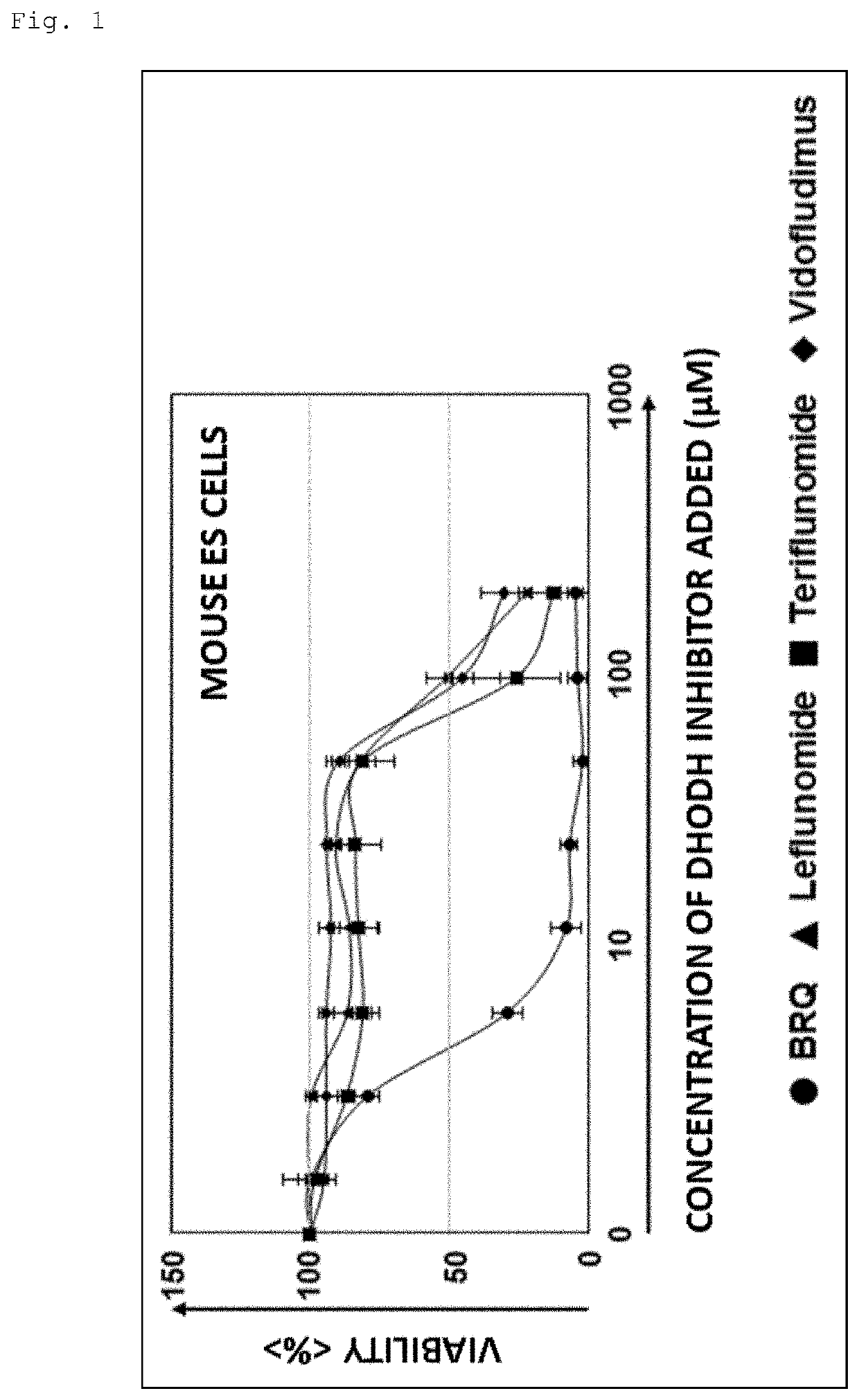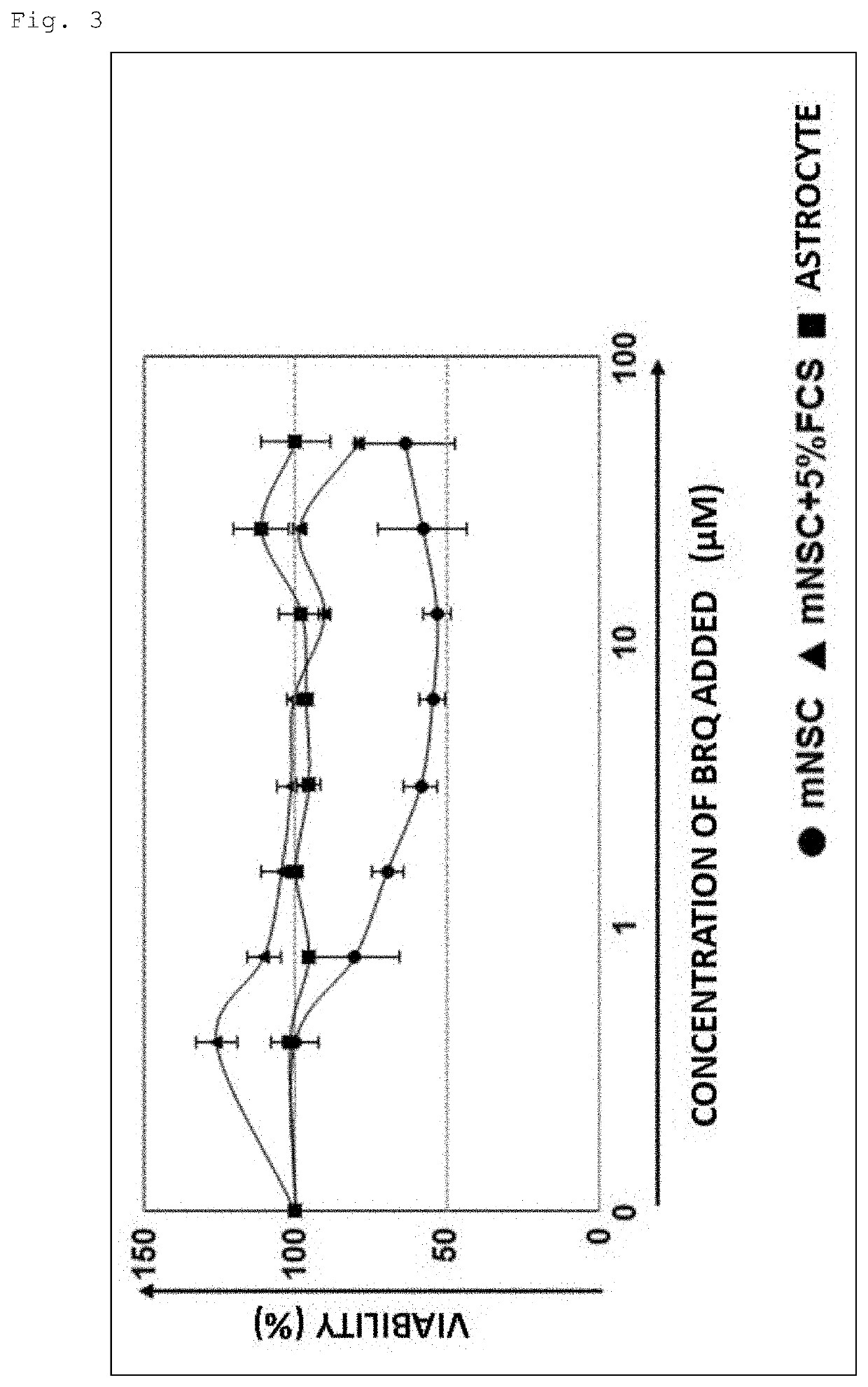Composition for removing pluripotent stem cells and method of removing pluripotent stem cells
a technology of pluripotent stem cells and compositions, applied in the field of compositions for methods of removing pluripotent stem cells, can solve the problems of unpractical use of the method of eliminating pluripotent stem cells with fewer side effects, tumors, etc., to eliminate undifferentiated pluripotent stem cells remaining
- Summary
- Abstract
- Description
- Claims
- Application Information
AI Technical Summary
Benefits of technology
Problems solved by technology
Method used
Image
Examples
example 1
Study on Cytotoxic Activity of DHODH Inhibitors Against Pluripotent Stem Cells
[0138]Mouse ES cells and mouse iPS cells were cultured for 3 days each in the presence of DHODH inhibitors (BRQ, leflunomide, teriflunomide, or vidofludimus), and viability was examined by MTT assay.
[0139]The results showed that all four DHODH inhibitors tested had cytotoxic activity against both types of pluripotent stem cells, as shown in FIGS. 1 and 2. In particular, BRQ showed significant cytotoxic activity against pluripotent stem cells even at low concentrations (from 10 μM). Note that the ICso of BRQ, leflunomide, teriflunomide, and vidofludimus against human-derived DHODH is 6 to 20 nM, 98 μM, 1 μM, and 134 nM, respectively. Therefore, the difference in cytotoxic activity against pluripotent stem cells among DHODH inhibitors appears to be due to the difference in inhibitory activity.
example 2
Study on Cytotoxic Activity of DHODH Inhibitors Against Somatic Stem Cells and the Like
[0140]Mouse normal neural stem cells (mNSC), mNSCs cultured in the presence of 5% fetal bovine serum (mNSC+5%FCS), and mouse astrocytes were cultured in the presence of 10 μM BRQ for 3 days, and the viability was examined by MTT assay. As a result, it was found that neural stem cells and neurons (differentiated cells) were hyposensitive to BRQ, as shown in FIG. 3.
[0141]Further, other pluripotent stem cells (NT2: human embryonal carcinoma (EC) cells) and other somatic stem cells (PA6: mouse bone marrow-derived stromal cells, C2C12: mouse myoblasts) were also cultured in the presence of 10 μM BRQ for 3 days, and the viability was examined by MTT assay. As a result, BRQ showed significant cytotoxic activity in pluripotent stem cells (ES cells, iPS cells, and EC cells), as shown in FIG. 4. On the other hand, there was a statistically significant difference between the viability of ES cells and iPS cel...
example 3
Verification of Cell-Specific Damaging Activity of DHODH Inhibitors on Pluripotent Stem Cells
[0142]Pluripotent stem cells (mouse ES cells or mouse iPS cells) and somatic stem cells (mouse neural stem cells), which were assumed to be cells obtained by differentiation from the cells, were mixed and cultured in ES cell medium containing BRQ at various concentrations for 3 days, and immunostaining for Nestin, an NSC marker, and Nanog, a pluripotent stem cell marker, was performed. As a result, as shown in FIGS. 5 and 6, ES cells and iPS cells were lost in the presence of 10 μM BRQ in the same manner as in FIGS. 1 to 4 above, but no obvious cytotoxicity to neural stem cells was observed.
PUM
| Property | Measurement | Unit |
|---|---|---|
| time | aaaaa | aaaaa |
| time | aaaaa | aaaaa |
| time | aaaaa | aaaaa |
Abstract
Description
Claims
Application Information
 Login to View More
Login to View More - R&D
- Intellectual Property
- Life Sciences
- Materials
- Tech Scout
- Unparalleled Data Quality
- Higher Quality Content
- 60% Fewer Hallucinations
Browse by: Latest US Patents, China's latest patents, Technical Efficacy Thesaurus, Application Domain, Technology Topic, Popular Technical Reports.
© 2025 PatSnap. All rights reserved.Legal|Privacy policy|Modern Slavery Act Transparency Statement|Sitemap|About US| Contact US: help@patsnap.com



